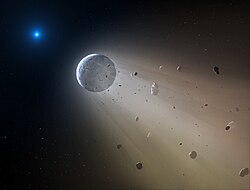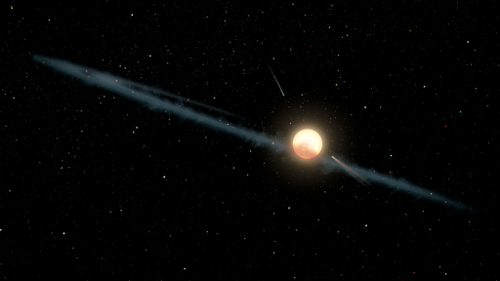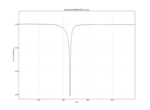破壊された惑星

このページ名「破壊された惑星」は暫定的なものです。(2021年9月) |
この項目「破壊された惑星」は翻訳されたばかりのものです。不自然あるいは曖昧な表現などが含まれる可能性があり、このままでは読みづらいかもしれません。(原文:英語版 "Disrupted planet" 06:19, 5 July 2021 (UTC)) 修正、加筆に協力し、現在の表現をより自然な表現にして下さる方を求めています。ノートページや履歴も参照してください。(2021年9月) |

破壊された惑星[要出典](英語: disrupted planet)とは、天文学において惑星や太陽系外惑星、それらより小さい微惑星、衛星、太陽系外衛星、小惑星などが近くに存在する別の天体によって破壊されたものである[1][2]。「Necroplanetology[注 1]」とはそのようなプロセスに関連している研究である[3][4]。天体が破壊された結果、発生したガス、塵、及び破片は過剰に生成される可能性があり、それらは最終的に星周円盤または塵円盤の形で主星を取り囲むとされる[5]。その結果、破片が周回する領域は不均一に塵が輪状になっている可能性があり、主星の見かけの光度に不規則な変動を引き起こす。これはKIC 8462852(タビーの星)やうお座RZ星、WD 1145+017のような変光星から観測された光の光度曲線が奇妙に変動していた原因と同じだった可能性がある[3][4]。このような恒星からは過剰な量の赤外線が検出される可能性があり[6]、塵や破片が恒星を周回している可能性があることを示す証拠となる[5][7][8][9]。
例[編集]
惑星[編集]
破壊された惑星、またはそのような惑星の一部であると考えられる惑星またはそれらに関連する残骸の例には、オウムアムア[10]及びWD 1145+017 b、ならびに小惑星[11]、ホット・ジュピター[12]が含まれる。また、仮説上の惑星としては仮説上の第5惑星やフェイトン、惑星V、テイアなどが含まれる。
恒星[編集]
惑星が破壊されたと考えられる主星の例には、EPIC 204278916、KIC 8462852(タビーの星)、PDS 110、うお座RZ星、おおぐま座47番星が存在する。

KIC 8462852(タビーの星)の光度曲線[編集]
KIC 8462852(タビーの星)は、F型主系列星であり、最大22%の明るさの減光など、異常な光の変動を示している[13]。これらの不規則な変化を説明するためにいくつかの仮説が提案されているが、これまでのところ、光度曲線のすべての様相を完全に説明しているものは存在していない。一つの説明は、不均一な塵の輪がKIC 8462852を周回しているということである[14][15]。しかし、2019年9月、天文学者は観測されたKIC 8462852の減光は惑星から孤立した太陽系外衛星の破壊に起因する破片によって生成された可能性があると報告した[16][17]。

- すべての光度曲線データ-2009年12月から2013年5月、スキャン日数0066から1587(ケプラー)
- 2013年4月17日-1568日目最大減光8%(ケプラー)
脚注[編集]
注釈[編集]
- ^ necroは死を表す接頭辞、planetは惑星、ologyは学問を表す。
- ^ g'-バンドとr'-バンドの減光の深さ(および形状)は、g'-バンドの方が波長が短く(0.47対0.62μm)、散乱した塵の影響に対してより影響を受けやすいため、異なる可能性がある。妥当な粒子サイズの分布(e.g., Hanson, 0.2μm)の場合、消光断面積比はg'-バンドでの深さx0.57であるr'-バンドでの深さを形成する。例えば、g'-バンドでの深さが0.3%の場合、r'-バンドでの深さは0.17%になる可能性がある。r'-バンドでの「Tabby Team」測定(Fig. 3)は、その小さな減光の深さと互換性がある。これらの形状はいずれも、太陽系外彗星の尾によるトランジットに似ていない(Rappaport et al, 2017 linkで説明されている)。したがって、これらの週の時間尺度の深さを生み出しているものは謎のままである。実際、長い楕円形はV字型のくぼみを生成することが知られている(傾斜の大きい輪を考える)。
出典[編集]
- ^ Staff (2017年12月22日). “Young Star RZ Piscium is 'Eating' Its Own Planets, Astronomers Say”. Sci-News.com. 2017年12月23日閲覧。
- ^ Fryling, Kevin (2017年12月21日). “IU astronomer's analysis helps discover that a star in the constellation Pisces is a 'planet-eater'”. Indiana University. 2017年12月23日閲覧。
- ^ a b Starr, Michelle (2020年3月28日). “Necroplanetology: The Strangest Field of Astronomy You've Never Heard Of”. ScienceAlert.com 2020年3月30日閲覧。
- ^ a b Duvvuri, Girish M.; Redfield, Seth; Veras, Dimitri (18 March 2020). “Necroplanetology: Simulating the Tidal Disruption of Differentiated Planetary Material Orbiting WD 1145+017”. The Astrophysical Journal 893 (2): 166. arXiv:2003.08410. Bibcode: 2020ApJ...893..166D. doi:10.3847/1538-4357/ab7fa0.
- ^ a b Punzi, K. M.; Kastner, J. H.; Melis, C.; Zuckerman, B.; Pilachowski, C.; Gingerich, L.; Knapp, T. (21 December 2017). “Is the Young Star RZ Piscium Consuming Its Own (Planetary) Offspring?”. The Astronomical Journal 155 (1): 33. arXiv:1712.08962. Bibcode: 2018AJ....155...33P. doi:10.3847/1538-3881/aa9524.
- ^ Farihi, J.; Jura, M.; Zuckerman, B. (10 March 2009). “Infrared Signatures of Disrupted Minor Planets at White Dwarfs”. The Astrophysical Journal 694 (2): 805–819. arXiv:0901.0973. Bibcode: 2009ApJ...694..805F. doi:10.1088/0004-637X/694/2/805.
- ^ Landau, Elizabeth (2017年10月4日). “Mysterious Dimming of Tabby's Star May Be Caused by Dust”. NASA. 2017年12月23日閲覧。
- ^ Meng, Huan Y.A. (3 October 2017). “Extinction and the Dimming of KIC 8462852”. The Astrophysical Journal 847 (2): 131. arXiv:1708.07556. Bibcode: 2017ApJ...847..131M. doi:10.3847/1538-4357/aa899c.
- ^ Tabor, Abby (2017年10月5日). “The scientific quest to explain Kepler's most enigmatic find”. Phys.org. 2017年12月23日閲覧。
- ^ Ćuk, Matija (2017). “1I/ʻOumuamua as a Tidal Disruption Fragment From a Binary Star System”. The Astrophysical Journal 852 (1): L15. arXiv:1712.01823. Bibcode: 2018ApJ...852L..15C. doi:10.3847/2041-8213/aaa3db.
- ^ Soter, Steven (2006). “What is a Planet?”. The Astronomical Journal 132 (6): 2513–2519. arXiv:astro-ph/0608359. Bibcode: 2006AJ....132.2513S. doi:10.1086/508861.
- ^ Nayakshin, Sergei (20 September 2011). “Hot Super Earths: disrupted young jupiters?”. Monthly Notices of the Royal Astronomical Society 416 (4): 2974–2980. arXiv:1103.1846. Bibcode: 2011MNRAS.416.2974N. doi:10.1111/j.1365-2966.2011.19246.x 2017年12月25日閲覧。.
- ^ Boyajian, T. S.; LaCourse, D. M.; Rappaport, S. A.; Fabrycky, D.; Fischer, D. A.; Gandolfi, D.; Kennedy, G. M.; Korhonen, H. et al. (2016-01-27). “Planet Hunters IX. KIC 8462852 – where's the flux?” (英語). Monthly Notices of the Royal Astronomical Society 457 (4): 3988–4004. arXiv:1509.03622. Bibcode: 2016MNRAS.457.3988B. doi:10.1093/mnras/stw218. ISSN 0035-8711.
- ^ “Mysterious Dimming of Tabby's Star May Be Caused by Dust”. NASA/JPL. 2018年11月13日閲覧。
- ^ Boyajian, Tabetha S.; Alonso, Roi; Ammerman, Alex; Armstrong, David; Ramos, A. Asensio; Barkaoui, K.; Beatty, Thomas G.; Benkhaldoun, Z. et al. (2018-01-19). “The First Post-Kepler Brightness Dips of KIC 8462852”. The Astrophysical Journal 853 (1): L8. arXiv:1801.00732. Bibcode: 2018ApJ...853L...8B. doi:10.3847/2041-8213/aaa405. ISSN 2041-8213.
- ^ Columbia University (2019年9月16日). “New observations help explain the dimming of Tabby's Star”. Phys.org 2019年9月16日閲覧。
- ^ Marinez, Miquel; Stone, Nicholas C.; Metzger, Brian D. (5 September 2019). “Orphaned Exomoons: Tidal Detachment and Evaporation Following an Exoplanet-Star Collision”. Monthly Notices of the Royal Astronomical Society 489 (4): 5119–5135. arXiv:1906.08788. Bibcode: 2019MNRAS.489.5119M. doi:10.1093/mnras/stz2464.
- ^ Gary, Bruce L. (2017年11月14日). “Hereford Arizona Observatory photometry observations of KIC 8462852”. BruceGary.net. 2017年12月24日閲覧。
- ^ Gary, Bruce L. (2017年10月4日). “Hereford Arizona Observatory photometry observations of KIC 8462852 between 2 May and 4 October 2017”. BruceGary.net. 2017年10月4日時点のオリジナルよりアーカイブ。2017年12月23日閲覧。
- ^ Gary, Bruce L. (2018年1月1日). “Hereford Arizona Observatory photometry observations of KIC 8462852 between 2 May and 31 December 2017”. BruceGary.net. 2018年1月2日時点のオリジナルよりアーカイブ。2018年1月1日閲覧。
- ^ Gary, Bruce L. (2018年5月4日). “Hereford Arizona Observatory photometry observations of KIC 8462852 between 2 May 2017 and 4 May 2018”. BruceGary.net. 2018年5月5日時点のオリジナルよりアーカイブ。2018年5月5日閲覧。
- ^ Gary, Bruce (2020年1月11日). “KIC 8462852 Hereford Arizona Observatory Photometry Observations #9”. 2020年4月5日時点のオリジナルよりアーカイブ。2020年4月5日閲覧。
参考文献[編集]
- Wallace Gary Ernst (1990). The Dynamic Planet. Columbia University Press. p. 18. ISBN 978-0-231-07231-1
- Michael M. Woolfson (2000). The Origin and Evolution of the Solar System. CRC Press. ISBN 978-1-4200-3335-9
関連項目[編集]
外部リンク[編集]
- NASA – WD 1145+017 b - 太陽系外惑星エンサイクロペディア.
- Video (13:46) − "Tabby's Star" - YouTube - Tabetha S. Boyajianによるプレゼンテーション.
- Video (31:00) − "Tabby's Star" - YouTube - Issac Arthurによるプレゼンテーション.
- Video (01:00) − RZ Piscium - YouTube - 異常な光の変動を伴う星(2017年12月21日).




![1年間の光度曲線-2018年5月4日まで(HAO)[18][19][注 2][20][21]](http://upload.wikimedia.org/wikipedia/commons/thumb/5/5d/KIC_8462852_Daily_Normalized_Flux_by_Bruce_Gary%2C_20170502-20180504.png/150px-KIC_8462852_Daily_Normalized_Flux_by_Bruce_Gary%2C_20170502-20180504.png)
![2019年10月10日から2020年1月11日までの光度曲線(HAO)[22]](http://upload.wikimedia.org/wikipedia/commons/thumb/8/8f/KIC_8462852_October-December_2019_Gary.jpg/150px-KIC_8462852_October-December_2019_Gary.jpg)